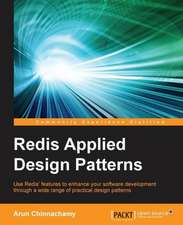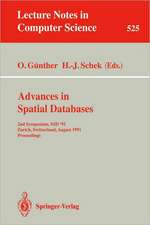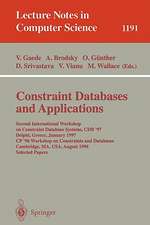Design and Implementation of Large Spatial Databases: First Symposium SSD '89. Santa Barbara, California, July 17/18, 1989. Proceedings: Lecture Notes in Computer Science, cartea 409
Editat de Alex Buchmann, Oliver Günther, Terence R. Smith, Yuan-Fang Wangen Limba Engleză Paperback – 7 feb 1990
Din seria Lecture Notes in Computer Science
- 20%
 Preț: 1061.55 lei
Preț: 1061.55 lei - 20%
 Preț: 307.71 lei
Preț: 307.71 lei - 20%
 Preț: 438.69 lei
Preț: 438.69 lei - 20%
 Preț: 579.30 lei
Preț: 579.30 lei -
 Preț: 410.88 lei
Preț: 410.88 lei - 17%
 Preț: 427.22 lei
Preț: 427.22 lei - 20%
 Preț: 596.46 lei
Preț: 596.46 lei - 15%
 Preț: 448.04 lei
Preț: 448.04 lei - 20%
 Preț: 353.50 lei
Preț: 353.50 lei -
 Preț: 389.49 lei
Preț: 389.49 lei - 20%
 Preț: 309.90 lei
Preț: 309.90 lei - 20%
 Preț: 645.28 lei
Preț: 645.28 lei - 20%
 Preț: 763.23 lei
Preț: 763.23 lei - 15%
 Preț: 580.46 lei
Preț: 580.46 lei - 20%
 Preț: 310.28 lei
Preț: 310.28 lei - 20%
 Preț: 655.02 lei
Preț: 655.02 lei - 20%
 Preț: 1183.14 lei
Preț: 1183.14 lei - 20%
 Preț: 340.32 lei
Preț: 340.32 lei -
 Preț: 449.57 lei
Preț: 449.57 lei - 20%
 Preț: 591.51 lei
Preț: 591.51 lei - 18%
 Preț: 938.83 lei
Preț: 938.83 lei - 20%
 Preț: 337.00 lei
Preț: 337.00 lei - 20%
 Preț: 649.50 lei
Preț: 649.50 lei - 20%
 Preț: 607.40 lei
Preț: 607.40 lei - 20%
 Preț: 1414.79 lei
Preț: 1414.79 lei - 20%
 Preț: 1024.44 lei
Preț: 1024.44 lei - 20%
 Preț: 583.40 lei
Preț: 583.40 lei - 20%
 Preț: 453.32 lei
Preț: 453.32 lei - 20%
 Preț: 575.49 lei
Preț: 575.49 lei - 20%
 Preț: 1075.26 lei
Preț: 1075.26 lei - 20%
 Preț: 585.88 lei
Preț: 585.88 lei - 20%
 Preț: 825.93 lei
Preț: 825.93 lei - 17%
 Preț: 360.20 lei
Preț: 360.20 lei - 20%
 Preț: 763.23 lei
Preț: 763.23 lei - 20%
 Preț: 340.32 lei
Preț: 340.32 lei - 20%
 Preț: 504.58 lei
Preț: 504.58 lei - 20%
 Preț: 369.13 lei
Preț: 369.13 lei - 20%
 Preț: 580.93 lei
Preț: 580.93 lei - 20%
 Preț: 343.62 lei
Preț: 343.62 lei - 20%
 Preț: 350.21 lei
Preț: 350.21 lei - 20%
 Preț: 583.40 lei
Preț: 583.40 lei - 20%
 Preț: 583.40 lei
Preț: 583.40 lei - 15%
 Preț: 438.59 lei
Preț: 438.59 lei - 20%
 Preț: 341.95 lei
Preț: 341.95 lei - 20%
 Preț: 238.01 lei
Preț: 238.01 lei - 20%
 Preț: 538.30 lei
Preț: 538.30 lei
Preț: 421.91 lei
Preț vechi: 527.39 lei
-20% Nou
Puncte Express: 633
Preț estimativ în valută:
80.73€ • 87.97$ • 68.03£
80.73€ • 87.97$ • 68.03£
Carte tipărită la comandă
Livrare economică 23 aprilie-07 mai
Preluare comenzi: 021 569.72.76
Specificații
ISBN-13: 9783540522089
ISBN-10: 3540522085
Pagini: 380
Ilustrații: XII, 372 p.
Dimensiuni: 160 x 240 x 20 mm
Greutate: 0.53 kg
Ediția:1990
Editura: Springer Berlin, Heidelberg
Colecția Springer
Seria Lecture Notes in Computer Science
Locul publicării:Berlin, Heidelberg, Germany
ISBN-10: 3540522085
Pagini: 380
Ilustrații: XII, 372 p.
Dimensiuni: 160 x 240 x 20 mm
Greutate: 0.53 kg
Ediția:1990
Editura: Springer Berlin, Heidelberg
Colecția Springer
Seria Lecture Notes in Computer Science
Locul publicării:Berlin, Heidelberg, Germany
Public țintă
ResearchCuprins
7±2 criteria for assessing and comparing spatial data structures.- The fieldtree: A data structure for geographic information systems.- A full resolution elevation representation requiring three bits per pixel.- The DASDBS GEO-Kernel, concepts, experiences, and the second step.- Performance comparison of point and spatial access methods.- Strategies for optimizing the use of redundancy in spatial databases.- Tiling large geographical databases.- Extending a database to support the handling of environmental measurement data.- Thematic map modeling.- Hierarchical spatial data structures.- Distributed quadtree processing.- Node distribution in a PR quadtree.- An object-oriented approach to the design of geographic information systems.- A topological data model for spatial databases.- A well-behaved file structure for the storage of spatial objects.- The design of pictorial databases based upon the theory of symbolic projections.- Reasoning on space with object-centered knowledge representations.- Qualitative spatial reasoning: A semi-quantitative approach using fuzzy logic.
























